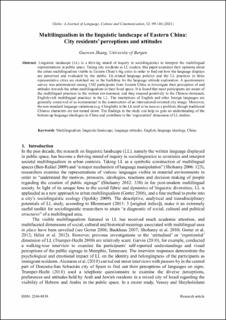| dc.contributor.author | Shang, Guowen | |
| dc.date.accessioned | 2021-07-09T11:39:20Z | |
| dc.date.available | 2021-07-09T11:39:20Z | |
| dc.date.created | 2021-02-18T09:56:26Z | |
| dc.date.issued | 2021 | |
| dc.identifier.issn | 2246-8838 | |
| dc.identifier.uri | https://hdl.handle.net/11250/2764053 | |
| dc.description.abstract | Linguistic landscape (LL) is a thriving strand of inquiry in sociolinguistics to interpret the multilingual representations in public space. Taking city residents as LL readers, this paper examines their opinions about the urban multilingualism visible in Eastern China’s big cities in order to find out how the language displays are perceived and evaluated by the public. LL-related language policies and the LL practices in three representative cities are sketched out as the backdrop for the language attitude exploration. A questionnaire survey was administered among 1302 participants from Eastern China to investigate their perception of and attitudes towards the urban multilingualism in their lived space. It is found that most participants are aware of the multilingual practices in the written environment, and they respond positively to the Chinese-dominant, English-rich multilingual practices in the LL. The inscriptions of English and other foreign languages are generally conceived of as instrumental in the construction of an international-oriented city image. Moreover, the non-standard language variations (e.g. Chinglish) in the LL tend to be seen as a problem, though traditional Chinese characters are not turned down. The findings in the study can help us gain an understanding of the bottom-up language ideologies in China and contribute to the ‘experiential’ dimension of LL studies. | en_US |
| dc.language.iso | eng | en_US |
| dc.publisher | Aalborg Universitetsforlag | en_US |
| dc.rights | Attribution-NonCommercial-NoDerivatives 4.0 Internasjonal | * |
| dc.rights.uri | http://creativecommons.org/licenses/by-nc-nd/4.0/deed.no | * |
| dc.title | Multilingualism in the linguistic landscape of Eastern China: City residents' perceptions and attitudes | en_US |
| dc.type | Journal article | en_US |
| dc.type | Peer reviewed | en_US |
| dc.description.version | publishedVersion | en_US |
| dc.rights.holder | Copyright the author | en_US |
| cristin.ispublished | true | |
| cristin.fulltext | original | |
| cristin.qualitycode | 1 | |
| dc.identifier.doi | https://doi.org/10.5278/ojs.globe.v12i.6501 | |
| dc.identifier.cristin | 1891188 | |
| dc.source.journal | Globe: A Journal of Language, Culture and Communication | en_US |
| dc.source.pagenumber | 99-116 | en_US |
| dc.identifier.citation | Globe: A Journal of Language, Culture and Communication. 2021, 12, 99-116. | en_US |
| dc.source.volume | 12 | en_US |

